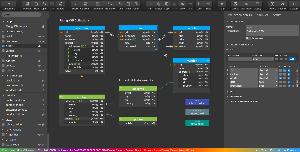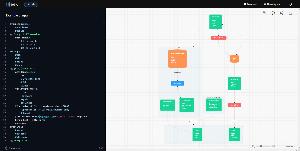Data modeling tools for MongoDB
List of data modeling and database design tools.
Data modeling is the process of creating and analyzing data models for resources stored in a database. The Data Model is an abstract model that standardizes the data description, data semantic, and consistency constraints of data. Its main purpose is to represent the types of data within a system, the relationships between objects, and its attributes. The data model helps to understand what data is needed and how data should be organized. It is like a blueprint for an architect to better understand what is being created.
ER/Studio
ER/Studio provides robust logical and physical modeling and determines all data sources along with managing the transformation of data between the staging area and data warehouse. It helps to build out an enterprise data model and represent business concepts with full documentation of attributes, definitions, relationships, etc.
| Desktop/Cloud: | Desktop |
|---|---|
| Commercial: | Commercial |
| Free edition: |
|
| ER Diagram: |
|
| Runs on: (for desktop): | Windows |
| Forward engineering: |
|
| Reverse enginering: |
|
| Synchronization: | - |
GenMyModel
With GenMyModel’s standard data modeling notation, data architects not only keep
glossaries and data models under control, but they can design and reverse engineer data
models and link them to other IT and business models, such as UML, Archimate and BPMN.
| Desktop/Cloud: | Cloud |
|---|---|
| Commercial: | Commercial |
| Free edition: |
|
| ER Diagram: |
|
| Runs on: (for desktop): | Linux,Mac OS,Windows |
| Forward engineering: |
|
| Reverse enginering: |
|
| Synchronization: | - |
Moon Modeler
Moon Modeler is a data modeling tool that lets you draw data models quickly and comfortably, create ER diagrams for databases, design nested structures, do documentation of schema design, reverse engineer, generate scripts, and more.
| Desktop/Cloud: | Desktop |
|---|---|
| Commercial: | Commercial |
| Free edition: |
|
| ER Diagram: |
|
| Runs on: (for desktop): | Linux,Mac OS,Windows |
| Forward engineering: |
|
| Reverse enginering: |
|
| Synchronization: |
|
Hackolade
Hackolade is a tool for Agile visual data modeling and provides graphic visualization of complex data structures using Entity-Relationship diagrams to represent denormalized data in a user-friendly way. Hackolade is specifically designed to handle the powerful nature of nested objects, denormalization, and polymorphic semi-structured schemas.
| Desktop/Cloud: | Desktop |
|---|---|
| Commercial: | Commercial |
| Free edition: |
|
| ER Diagram: |
|
| Runs on: (for desktop): | Linux,Mac OS,Windows |
| Forward engineering: |
|
| Reverse enginering: |
|
| Synchronization: | - |
Gleek.io
Gleek.io diagram maker is freemium text-to-diagram tool for developers and software architects. It is a cloud tool for model driven software development, and you can run in any browser. Gleek.io is designed to be used during software planning meetings and live collaboration, so it is vital that diagrams can be created quickly.
| Desktop/Cloud: | Cloud |
|---|---|
| Commercial: | Commercial |
| Free edition: |
|
| ER Diagram: |
|
| Runs on: (for desktop): | - |
| Forward engineering: |
|
| Reverse enginering: |
|
| Synchronization: |
|
Tree Schema
The Tree Schema data catalog provides all of the essential catalog capabilities including rich-text documentation, data lineage, assigning data stewards and technical owners to your data assets, tagging your assets and much more. You can point Tree Schema to your database and fully populate your catalog in under 5 minutes. Tree Schema also supports non-traditional data sources including S3, Kafka and DynamoDB.
| Desktop/Cloud: | - |
|---|---|
| Commercial: | Commercial |
| Free edition: |
|
| ER Diagram: | - |
| Runs on: (for desktop): | - |
| Forward engineering: | - |
| Reverse enginering: | - |
| Synchronization: | - |
The wider the scope of data works in an organization, the more advanced data modeling tool is needed. The functionality spectrum of these tools can be very broad. However, the core features of these tools include:
 SQL Server
SQL Server
 Oracle
Oracle
 MySQL
MySQL
 PostgreSQL
PostgreSQL
 Amazon Redshift
Amazon Redshift
 Azure SQL Database
Azure SQL Database
 DBT
DBT
 Google Big Query
Google Big Query
 IBM DB2
IBM DB2
 MariaDB
MariaDB
 SAP HANA
SAP HANA
 Snowflake
Snowflake
 SQLite
SQLite
 Teradata
Teradata
 Vertica
Vertica









